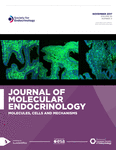Astrocytes: new targets of melanocortin 4 receptor actions
- School of Medicine, Biomedical Research Institute (UBA-CONICET), University of Buenos Aires, Paraguay 2155 piso 10, 1121ABG Buenos Aires, Argentina
1IFEC (CONICET) Department of Pharmacology, School of Chemistry, National University of Córdoba, Córdoba, Argentina
- Correspondence should be addressed to M Lasaga; Email: mlasaga{at}fmed.uba.ar
Abstract
Astrocytes exert a wide variety of functions with paramount importance in brain physiology. After injury or infection, astrocytes become reactive and they respond by producing a variety of inflammatory mediators that help maintain brain homeostasis. Loss of astrocyte functions as well as their excessive activation can contribute to disease processes; thus, it is important to modulate reactive astrocyte response. Melanocortins are peptides with well-recognized anti-inflammatory and neuroprotective activity. Although melanocortin efficacy was shown in systemic models of inflammatory disease, mechanisms involved in their effects have not yet been fully elucidated. Central anti-inflammatory effects of melanocortins and their mechanisms are even less well known, and, in particular, the effects of melanocortins in glial cells are poorly understood. Of the five known melanocortin receptors (MCRs), only subtype 4 is present in astrocytes. MC4R has been shown to mediate melanocortin effects on energy homeostasis, reproduction, inflammation, and neuroprotection and, recently, to modulate astrocyte functions. In this review, we will describe MC4R involvement in anti-inflammatory, anorexigenic, and anti-apoptotic effects of melanocortins in the brain. We will highlight MC4R action in astrocytes and discuss their possible mechanisms of action. Melanocortin effects on astrocytes provide a new means of treating inflammation, obesity, and neurodegeneration, making them attractive targets for therapeutic interventions in the CNS.
- Revision received 27 June 2013
- Accepted 23 July 2013
- Made available online as an Accepted Preprint 23 July 2013
- © 2013 Society for Endocrinology











